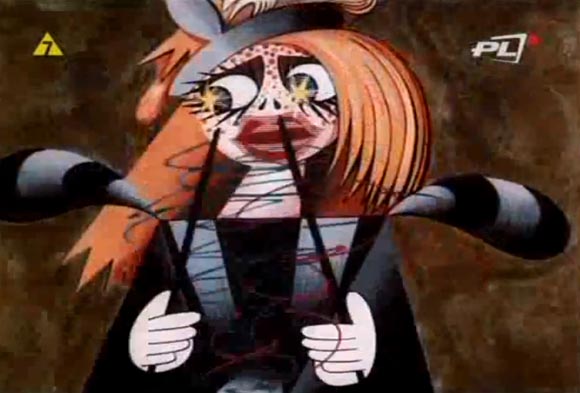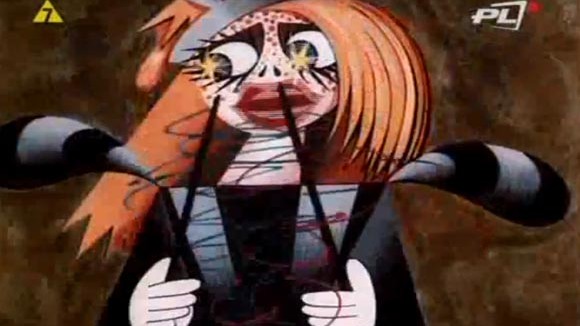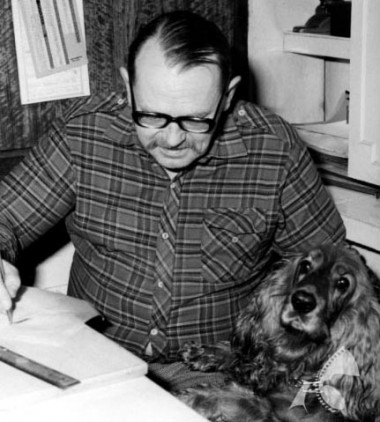

Prepare Yourself For This Trippy, Incredible Piece of Polish Animation
Starting with its title—Dziwne dziwy, czyli… Baśń o Korsarzu Palemonie—this Polish film is nearly impossible to explain. As soon as the title of the film appears onscreen, the letters of the title morph into question marks and exclamation points, which then melt into a flag adorned with a skull that is smoking a pipe. The skull emits pipe smoke out of its eye, which quickly engulfs the screen. Then, the sun breaks through and shines. And that’s just the first 10 seconds! Add another 30 minutes of uninterrupted surrealist insanity and you begin to get an idea of this incredible piece of film.
 Krzysztof Dębowski (pictured left), a veteran of the Polish animation scene, was in the twilight of his career when he made this film in 1986. It’s a difficult film to classify because it doesn’t fit into any conventional timeline of animation history. Some of the character designs are a throwback to the blocky ‘cartoon modern’ style of Sixties and Seventies Eastern European animation, but the facial expressions resemble the crude graphic exaggeration of manga and the cartoonish painted stills foreshadow the Spumco style of the early-1990s. Such efforts to compare the film’s individual elements to other visual work are inadequate though. It is the totality of Dębowski’s vision that is so striking and utterly original.
Krzysztof Dębowski (pictured left), a veteran of the Polish animation scene, was in the twilight of his career when he made this film in 1986. It’s a difficult film to classify because it doesn’t fit into any conventional timeline of animation history. Some of the character designs are a throwback to the blocky ‘cartoon modern’ style of Sixties and Seventies Eastern European animation, but the facial expressions resemble the crude graphic exaggeration of manga and the cartoonish painted stills foreshadow the Spumco style of the early-1990s. Such efforts to compare the film’s individual elements to other visual work are inadequate though. It is the totality of Dębowski’s vision that is so striking and utterly original.
Dębowski gleefully disregards the Western animator’s narrow-minded obsession with achieving the “illusion of life.” He breaks every rule that is sacred to the character animator and moves things however he damn pleases. His universe functions on the level of pure graphic cinema and exists exclusively on its own terms. Characters distort in grotesque ways, and they move in fits and starts that suggest human locomotion in only the most abstract sense. Dębowski has no use for things like perspective and instead suggests space through design and movement. Effects like waves, clouds and cannon fire are conveyed through gorgeous patterns of shapes and lines that move to their own unique rhythms.

The film is visually lush, but its heavy narration makes it difficult to decipher. I called upon Pawel Wieszczecinski, a film studies major at the New School in Manhattan as well as the founder of the Kinoscope film series, to explain what I was looking at. Here’s what he told me:
The title is “A Fairytale about Palemon the Pirate.” This particular film is based on a fairytale by a famous fable writer named Jan Brzechwa. His stories are generally aimed at young audiences. I even remember his fairytales from when I was a kid. He is definitely the most famous fairytale writer in Poland. This particular piece was written in 1956. It’s about a King who dies, but before he does so, he announces to his four daughters that the one who will overcome the Palemon the Pirate will get the crown. Palemon owns all the seas and his empire is enormous. Eventually one of King’s daughters, the ugliest one, conquers Palemon’s empire and she becomes the new Queen. But besides that, she also hooks up with Palemon and they get married.

Dębowski should be an animation legend on the basis of this film alone. Yet, I’d never heard of him until I randomly stumbled across this film during a late-night cartoon binge. Further searching yields absolutely nothing written about him in the English language. His lack of recognition in the West is a shame considering his prolific body of work. He started directing in 1960 at Studio Miniatur Filmowych and made dozens of films over the next thirty years. The only other example of his work that I can find online is this early piece called Wzeszło słoneczko.







.png)